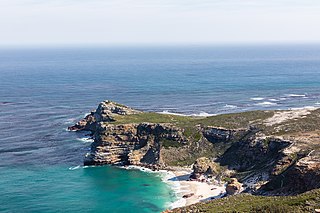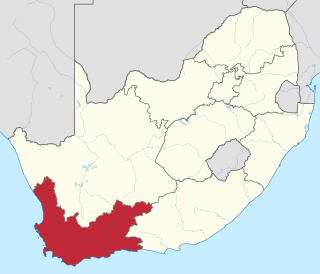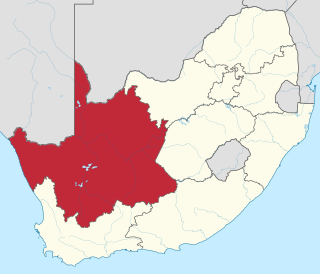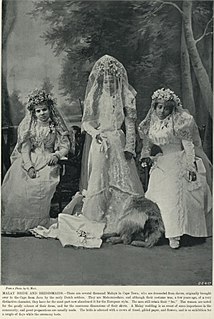Related Research Articles

Afrikaans is a West Germanic language spoken in South Africa, Namibia and, to a lesser extent, Botswana and Zimbabwe. It evolved from the Dutch vernacular of Holland spoken by the largely Dutch settlers in the south-west of what is now South Africa, where it gradually began to develop distinguishing characteristics in the course of the 18th century. Hence, it is a daughter language of Dutch.

Boer is Dutch and Afrikaans for "farmer". In South African contexts, "Boers" refers to the descendants of the proto-Afrikaans-speaking settlers of the eastern Cape frontier in Southern Africa during the 18th and much of the 19th century. From 1652 to 1795 the Dutch East India Company controlled this area, but the United Kingdom incorporated it into the British Empire in 1806.

Cape Town is the second most populous city in South Africa after Johannesburg and also the legislative capital of South Africa. Colloquially named the Mother City, it is the largest city of the Western Cape province and forms part of the City of Cape Town metropolitan municipality. The Parliament of South Africa sits in Cape Town. The other two capitals are located in Pretoria and Bloemfontein. The city is known for its harbour, for its natural setting in the Cape Floristic Region, and for landmarks such as Table Mountain and Cape Point. Cape Town is home to 64% of the Western Cape's population. The city was named the World Design Capital for 2014 by the International Council of Societies of Industrial Design.

The Cape of Good Hope is a rocky headland on the Atlantic coast of the Cape Peninsula in South Africa.

The Cape of Good Hope, also known as the Cape Colony, was a British colony in present-day South Africa, named after the Cape of Good Hope. The British colony was preceded by an earlier Dutch colony of the same name, the Kaap de Goede Hoop, established in 1652 by the Dutch East India Company. The Cape was under Dutch rule from 1652 to 1795 and again from 1803 to 1806. The Dutch lost the colony to Great Britain following the 1795 Battle of Muizenberg, but had it returned following the 1802 Peace of Amiens. It was re-occupied by the UK following the Battle of Blaauwberg in 1806, and British possession affirmed with the Anglo-Dutch Treaty of 1814.

The Union of South Africa is the historical predecessor to the present-day Republic of South Africa. It came into being on 31 May 1910 with the unification of the Cape Colony, the Natal Colony, the Transvaal, and the Orange River Colony. It included the territories that were formerly a part of the South African Republic and the Orange Free State.

The Province of the Cape of Good Hope, commonly referred to as the Cape Province and colloquially as The Cape, was a province in the Union of South Africa and subsequently the Republic of South Africa. It encompassed the old Cape Colony, as well as Walvis Bay, and had Cape Town as its capital. Following the end of the Apartheid era, the Cape Province was split up to form the new Eastern Cape, Northern Cape and Western Cape provinces, along with part of the North West.

The first modern humans are believed to have inhabited South Africa more than 100,000 years ago. South Africa's prehistory has been divided into two phases based on broad patterns of technology namely the Stone Age and Iron Age. After the discovery of hominins at Taung and australopithecine fossils in limestone caves at Sterkfontein, Swartkrans, and Kromdraai these areas were collectively designated a World Heritage site. The first inhabitants of South Africa are collectively referred to as the Khoisan, the Khoi Khoi and the San separately. These groups were displaced or sometimes absorbed by migrating Africans (Bantus) during the Bantu expansion from Western and Central Africa. While some maintained separateness, others were grouped into a category known as Coloureds, a multiracial ethnic group which includes people with shared ancestry from two or more of these groups: Khoisan, Bantu, English, Afrikaners, Austronesians, East Asians and South Asians. European exploration of the African coast began in the 13th century when Portugal committed itself to discover an alternative route to the silk road that would lead to China. In the 14th and 15th century, Portuguese explorers traveled down the west African Coast, detailing and mapping the coastline and in 1488 they rounded the Cape of Good Hope. The Dutch East India Company established a trading post in Cape Town under the command of Jan van Riebeeck in 1652, European workers who settled at the Cape became known as the Free Burghers and gradually established farms in the Dutch Cape Colony.

In Southern Africa, Cape Coloureds are an ethnic group composed primarily of persons of mixed race. Although Cape Coloureds form a minority group within South Africa, they are the predominant population group in the Western Cape.

Coloureds are a multiracial ethnic group native to Southern Africa who have ancestry from more than one of the various populations inhabiting the region, including Khoisan, Bantu, Afrikaner, Whites, Austronesian, East Asian or South Asian. Because of the combination of ethnicities, different families and individuals within a family may have a variety of different physical features.

The Eastern Cape is one of the provinces of South Africa. Its capital is Bhisho, but its two largest cities are East London and Port Elizabeth.

The Western Cape is a province of South Africa, situated on the south-western coast of the country. It is the fourth largest of the nine provinces with an area of 129,449 square kilometres (49,981 sq mi), and the third most populous, with an estimated 6.6 million inhabitants in 2018. About two-thirds of these inhabitants live in the metropolitan area of Cape Town, which is also the provincial capital. The Western Cape was created in 1994 from part of the former Cape Province, The two largest cities are Cape Town and George

The Northern Cape is the largest and most sparsely populated province of South Africa. It was created in 1994 when the Cape Province was split up. Its capital is Kimberley. It includes the Kalahari Gemsbok National Park, part of the Kgalagadi Transfrontier Park, an international park shared with Botswana. It also includes the Augrabies Falls and the diamond mining regions in Kimberley and Alexander Bay. The Namaqualand region in the west is famous for its Namaqualand daisies. The southern towns of De Aar and Colesberg, in the Great Karoo, are major transport nodes between Johannesburg, Cape Town and Port Elizabeth. In the northeast, Kuruman is known as a mission station and also for its artesian spring, the Eye of Kuruman. The Orange River flows through the province, forming the borders with the Free State in the southeast and with Namibia to the northwest. The river is also used to irrigate the many vineyards in the arid region near Upington.

The University of Cape Town (UCT) is a public research university located in Cape Town in the Western Cape province of South Africa. UCT was founded in 1829 as the South African College making it the oldest higher education institute in South Africa. In terms of full university status, it is jointly the oldest university in South Africa and the oldest extant university in Sub-Saharan Africa alongside Stellenbosch University which received full university status on the same day in 1918.

Cape Malays are an ethnic group or community in South Africa. The name is derived from the Cape of Good Hope and the Malay people originally from Malay archipelago, mostly from the Dutch East Indies colony, a Dutch colony for several centuries, and Dutch Malacca, which the Dutch held from 1641 to 1824. The community's earliest members were enslaved Javanese transported by the Dutch East India Company. They were followed by slaves from various other Southeast Asian regions, and political dissidents and Muslim religious leaders who opposed the Dutch presence in what is now Indonesia and were sent into exile. Malays also have significant South Asian (Indian) slave ancestry. Starting in 1654, these resistors were imprisoned or exiled in South Africa by the Dutch East India Company, which founded and used what is now Cape Town as a resupply station for ships travelling between Europe and Asia. They were the group that first introduced Islam to South Africa. By the 19th century, the term was used to describe anyone at the Cape who was a practicing Muslim, irrespective of ethnic background. As such, most Cape Malays were actually from Madagascar and East Africa, shipped to the Cape as slaves from the end of the 18th century, who converted upon arrival.

The Cape Corps and its predecessor units were the main military organisations in which the Coloured members of South Africa's population served.

Port Elizabeth or Nelson Mandela Bay often known by its initials PE, and colloquially as “The Friendly City”, is a major seaport city and most populous city in the Eastern Cape province of South Africa. Port Elizabeth is the seat of the Nelson Mandela Bay Metropolitan Municipality, South Africa's second largest metropolitan district by area. It is the most-populous city of the Eastern Cape and the sixth most-populous city in South Africa. the most-populous city of Eastern Cape; and the cultural, economic and financial center of the Eastern Cape. The city is among the top five cities in the world for pleasant weather, according to a 2014 scientific climate study of 600 global cities. Port Elizabeth is known for many blue-flag beaches along the city's urban coastline; its popularity as an international and local holiday destination; and its rich and diverse cultural heritage. It is a tourism gateway city for the Eastern Cape and the only city with the closest proximity to malaria-free big five game reserves.

South Africa, officially the Republic of South Africa (RSA), is the southernmost country in Africa. With over 58 million people, it is the world's 24th-most populous nation and covers an area of 1,221,037 kilometres (758,717 mi). South Africa has three designated capital cities: executive Pretoria, judicial Bloemfontein and legislative Cape Town. The largest city is Johannesburg. About 80% of South Africans are of Bantu ancestry, divided among a variety of ethnic groups speaking different African languages. The remaining population consists of Africa's largest communities of European, Asian, Indian, and multiracial ancestry.
Afrikaners are a Southern African ethnic group descended from predominantly Dutch settlers first arriving at the Cape of Good Hope in the 17th and 18th centuries. They traditionally dominated South Africa's politics and commercial agricultural sector prior to 1994. Afrikaans, South Africa's third most widely spoken home language, evolved as the mother tongue of Afrikaners and most Cape Coloureds. It originated from the Dutch vernacular of South Holland, incorporating words brought from the Dutch East Indies and Madagascar by slaves. Afrikaners make up approximately 5.2% of the total South African population based on the number of white South Africans who speak Afrikaans as a first language in the South African National Census of 2011.

The 2019–20 coronavirus pandemic spread to South Africa with Minister of Health Zweli Mkhize announcing the first confirmed case on 5 March 2020 - the patient being a South African returning from Italy.
References
- ↑ "Contact Directory". Republic of South Africa: Government Communication and Information System. Retrieved 8 September 2011.
| This South African newspaper-related article is a stub. You can help Wikipedia by expanding it. |